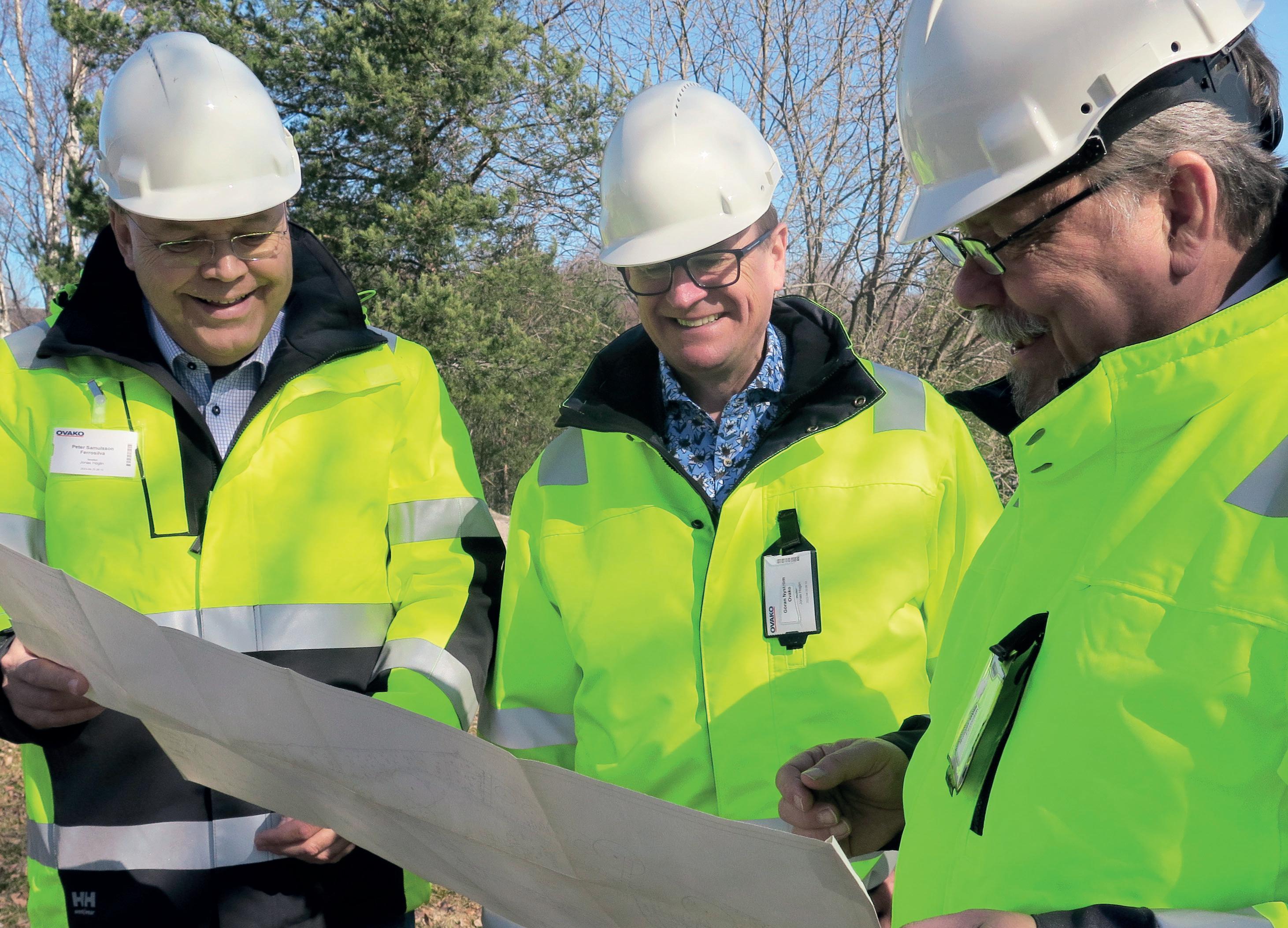
6 minute read
FerroSilva – combining iron production with a carbon sink
With an expanding economy, demand for steel is increasing – making the optimal use of resources a priority. FerroSilva, a project involving multiple steelmakers, suppliers, and academics, offers the novel use of biogenic material as a reducing agent in DRI production – with plans to build its first plant and commence operations by 2026. By Rutger Gyllenram*, Peter Samuelsson** and Göran Nyström***
IT is not difficult to produce iron from iron ore; we have done that for a couple of thousand years. Fossil free iron production was the dominant way until the coking process was invented at the end of the eighteenth century, and charcoal blast furnaces are still used in some countries. However, high-volume, low-cost production demanded the unmatched energy efficiency of the blast furnace process and the smooth logistics of fossil coal – so the blast furnace/ basic oxygen furnace is the dominant process route for steel from iron ore. This position is now challenged by the need to decrease global emissions of carbon dioxide in order to avoid a climate catastrophe.
*Founder and CEO, Kobolde AB
The transition to fossil free iron is a challenge
It is human to hope for a new metallurgical process that will solve all our problems immediately. However, abating emissions of climate gases is an issue not only for the steel industry but for all people, and replacing coal will make almost all other
**MSc in metallurgy and materials science, PhD in metallurgy, KTH Royal Institute of Technology
***MSc in materials physics, Uppsala University resources scarce for the decades to come, and process development will to a large extent depend on optimal use of limited resources. The transition to fossil-free steel will affect every aspect of steelmaking. Blast furnaces that are modified and combined with CCUS, will probably keep their position in order to make use of high gangue ores. Direct reduction from reformed natural gas combined with CCUS and followed by melting in electric arc furnaces using renewable electricity is one alternative and finally, making the reduction with hydrogen made from fossil-free electricity is another. They will all have their place in due time when technology reaches a high readiness level and new trade patterns are stabilised.
Biogenic material as a source of reducing agent
From both an economical and an ecological perspective, the optimal route would be to benefit from resources that are not used to their full potential today. Such resources include sawmill waste and forest residue, i.e., tops and branches. The latter is often not harvested but left to rot. Other biogenic resources can be found in the vast and diversified agricultural sector. The drawback of biogenic material is that it is voluminous, it often must be collected from large areas, and the available volumes are limited. There is however more biogenic raw material available than is normally recognised and logistic systems are being developed that can manage the material. The price is normally determined by the value of generated district heating and electricity which limits acceptable costs for transport and building up logistic systems. If, on the other hand, the product is a reducing gas that can replace natural gas or hydrogen, the value is higher and can cover more extensive harvesting and transport, which increases availability. The final advantage is that biomass generates biogenic carbon dioxide that does not require allowances and when stored, or used in products, creates a carbon sink.

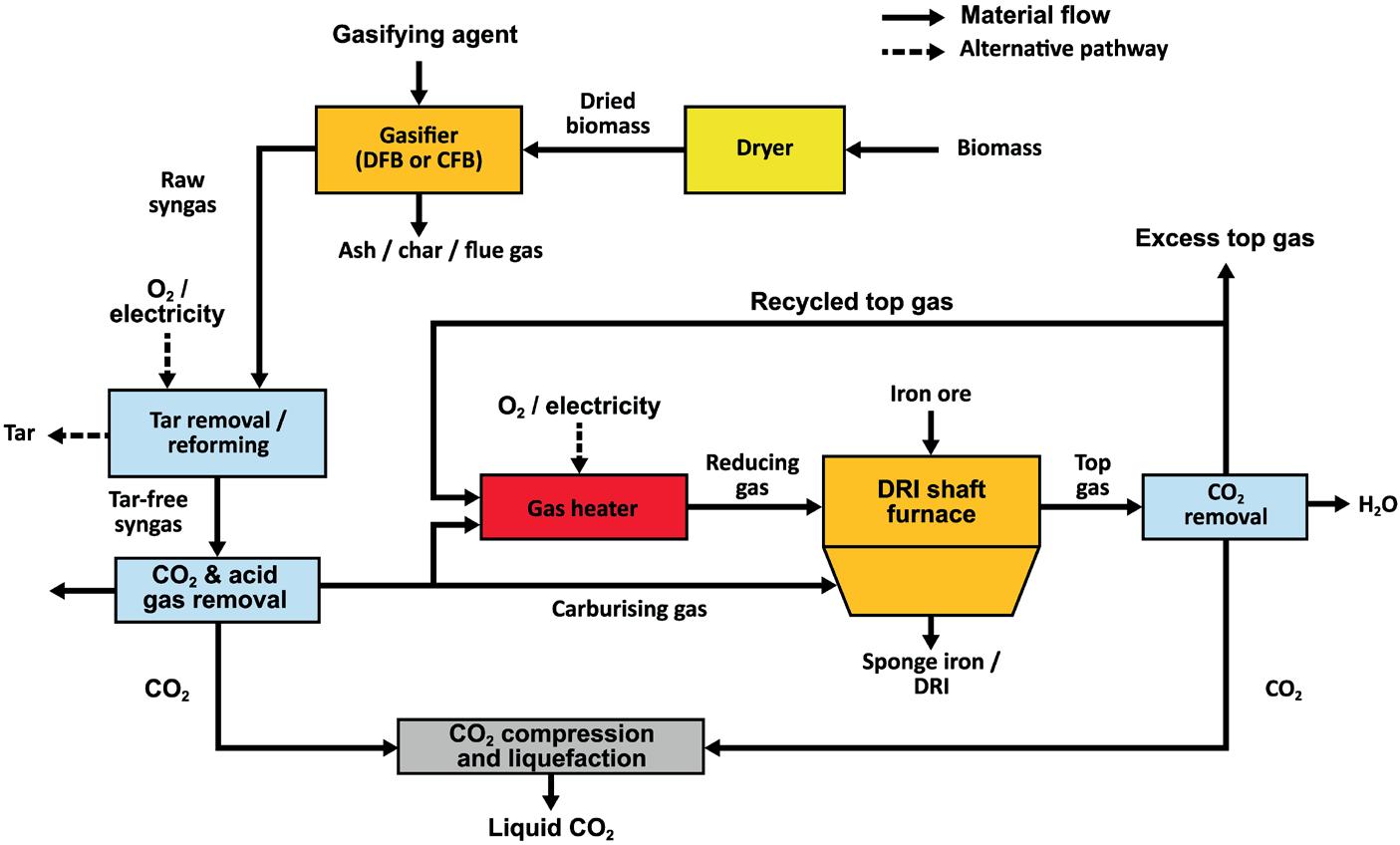
Closing blast furnaces creates demand for DRI
When the number of electric arc furnaces increases and the number of blast furnaces decreases there is a risk of a shortage of high-grade scrap with low amounts of tramp elements. This was the major concern that made three Swedish steel companies,
Ovako, Alleima and Uddeholm, team up with two providers of wood chips and saw dust pellets, Sveaskog and Lantmännen. Together with KTH Royal Institute of Technology and Chalmers University of Technology, M3Advice and Kobolde & Partners, and with additional financing from the Swedish Energy Agency, the consortium performed a feasibility study finalised in September 2022. This has now resulted in plans to build a first FerroSilva plant of 50kt of DRI at the Ovako Hofors plant with the intention to start production in 2026.
The FerroSilva process
The process is based on three technology building blocks, all of them in operation at full scale, but can be found across three separate industrial segments.
Gasification in a fluidised bed is nothing new and can be found at some companies in the pulp and paper industries. Often the aim is to produce heat or electricity. In this case the product is a biogenic syngas with a composition close to what is achieved when reforming natural gas. Today, there are the following designs available with a high technical readiness level; TRL, Dual Fluidised Bed (DFB), and Circulating Fluidised Bed (CFB), all with slightly different performances. The biomass is dried before it is entered into the gasifier where a raw syngas is produced as is shown in Fig 1 The tar is then removed and after that, carbon dioxide and acid gases. The carbon dioxide removal process is commonly used in refineries and petrochemical plants. The resulting gas is then either heated and injected as reduction gas into a DR-shaft of the same type as is used for reformed natural gas, or injected cold in the bottom as cooling carburising gas. Carbon dioxide and water is removed from the top gas and hydrogen and carbon monoxide is recycled as reduction gas. The high-grade iron ore pellets that are charged at the top of the furnace leave the shaft as DRI. The shaft furnace is like the ones already applied today in the natural gas processes. Finally, the captured biogenic carbon dioxide is compressed, liquified and transported to a partner for further processing. (Fig 1)


The key to efficiency is to use energy streams in the process. Approximately 1.4 tons or 3.7 m3 biomass is used, equal to 3500kWh. Electricity use is 300kWh and biogenic carbon dioxide generation is approximately 1 ton per ton of DRI.

Life cycle assessment for steel using FerroSilva DRI
The three major environmental impacts that must be observed in the FerroSilva process form the Global Warming Potential (GWP) which in large part is about uptake and emissions of carbon dioxide and other climate gases, the soil carbon, and the biodiversity. For a company like FerroSilva, all these three are of great importance and demand close co-operation in the supply chain.
Working with certified forestry companies and following up on research and compliance with standards is part of the core business.
For carbon dioxide, the follow-up must include how the captured liquid gas is transported and processed to new materials or fuel.

Fig 2 shows the GWP, i.e., the carbon dioxide equivalents balance, for one ton of crude steel made in an electric arc furnace from FerroSilva DRI. As can be seen, the steelmaking and carbon dioxide liquefaction emits 360kg direct and indirect emissions (scope 1-3). This leaves a carbon sink of 845kg if this carbon dioxide is brought out of the circuit or used to replace fossil carbon in any way.
Cost of the reducing agent


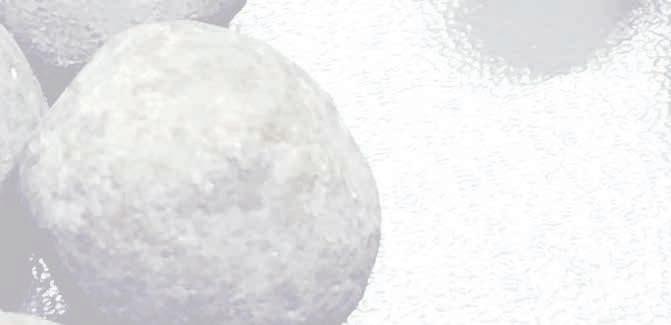
It is always tricky to compare production costs from processes that do not yet exist. Reduction with natural gas and 100% CCS of the generated CO2, full-scale reduction with hydrogen or using biogenic syngas and CCU are here compared using published consumption figures and investment costs based on a reference case and estimated differences between the different technologies. As can be seen in Fig 3 the price of the reduction agent has a huge impact on the production cost. The price in euros for natural gas and biomass per MWh is shown on the x-axis, and production costs in EUR/ton DRI on the y-axis. The thickness of the lines shows the difference in cost between in a price range for electricity between 32 and 65 EUR/MWh.
The calculations are made with varying energy prices, iron ore costs, and transportation. This means that distance to the mine or the market may change the differences in production cost between technologies. For FerroSilva, the calculation indicates that it is competitive at a medium natural gas price.
Building a first plant
The first FerroSilva plant is planned to be located within the production site of Ovako in Hofors. There are excellent rail and road connections and much of the needed utilities infrastructure are available in proximity to the FerroSilva plant, including the residential district heating, where residual energies from the
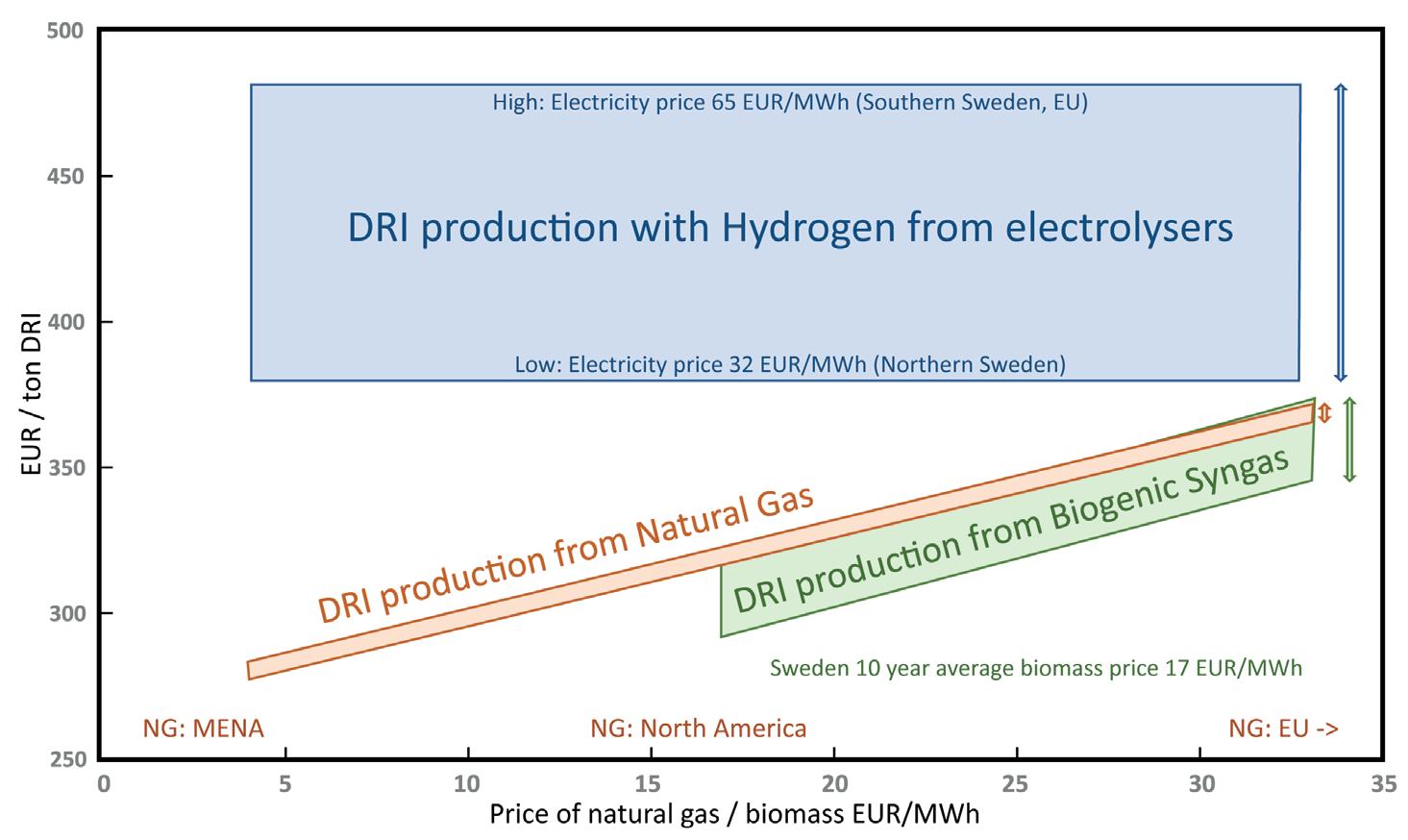
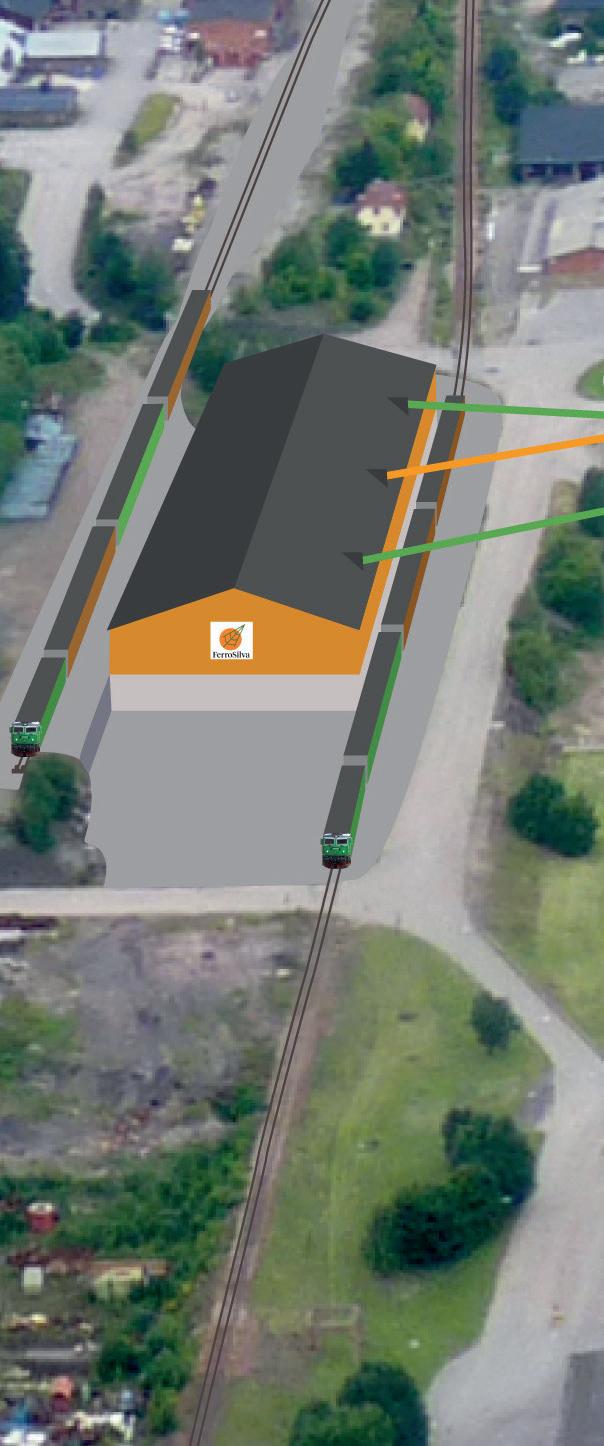

DRI production can be put to good use. Furthermore, the process for securing environmental permits will be substantially simplified, being within Ovako’s industrial area rather than at a greenfield site.
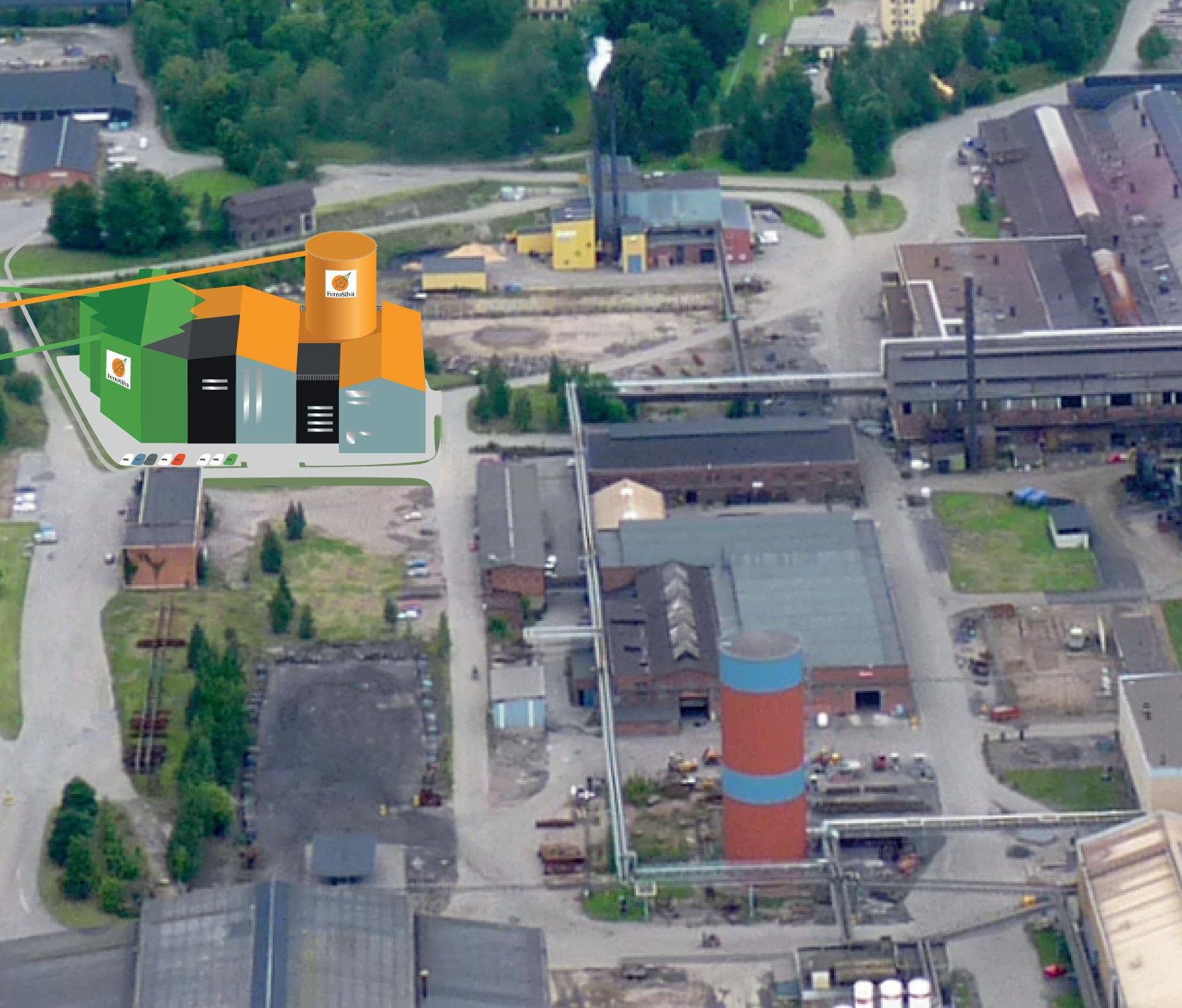
The melt shop where the produced DRI will be used in steelmaking operations is located some 200 metres away from the FerroSilva plant. Liquid carbon dioxide will be shipped via rail to other users, such as the production of bio-methanol, that can be used for the production of aviation fuel, but also for further synthesis into products that today are reliant on fossil raw material; such as plastics, pharmaceuticals etc.
The way forward
With an expanding global economy, demand for steel is increasing and using our resources in an optimal way is necessary. A sustainable use of biogenic material with the FerroSilva process will no doubt play an important role in countries with a well-managed sustainable forest industry. The same is also valid for countries with a significant agricultural industry, where substantial quantities of residues are available. Contrary to the popular view, suitable bio resources, and thus residues, are available in many parts of the world and are not limited to the boreal and northern temperate forest ecosystems. After setting up the initial plant, the plan is to construct and commission an even larger scale plant and to further expand the geographical footprint of the FerroSilva technology.
For further information, log on to www.ferrosilva.com, or email info@ferrosilva.com










